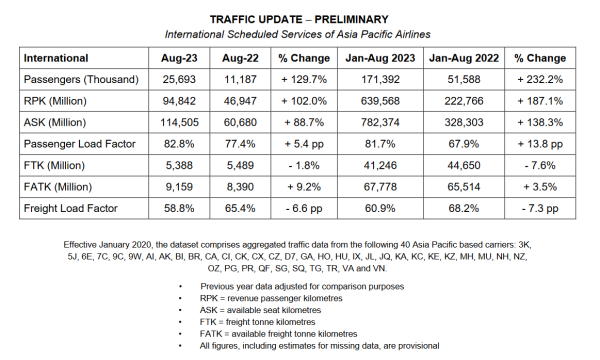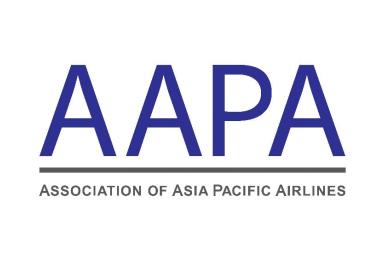KUALA LUMPUR, 6 October 2023: Preliminary August 2023 traffic figures released Wednesday by the Association of Asia Pacific Airlines (AAPA) showed further recovery in international passenger markets, underpinned by robust travel demand and expansion in city-pair connections from both outside and within the region.
Asia Pacific airlines carried 25.7 million international passengers in August, a solid 129.7% year-on-year growth compared to last year, bringing demand to an average of 76.5% of pre-pandemic levels. In revenue passenger kilometres (RPK), demand rose 102.0% year-on-year, while available seat capacity expanded by 88.7%, leading to a 5.4 percentage point increase in the average international passenger load factor to 82.8%.

Meanwhile, renewed declines in export orders prolonged the decline in air cargo markets. Demand, as measured in freight tonne kilometres (FTK), saw a slight 1.8% year-on-year fall in August compared to the subdued volumes recorded in the same month last year. The international freight load factor remained under pressure, recording a 6.6 percentage point decline to an average of 58.8% for the month, after accounting for a 9.2% year-on-year expansion in offered freight capacity.
Commenting on the results, AAPA director general Subhas Menon said: “Despite the moderation in global economic activity, demand has continued to grow in the services sectors, including travel and tourism. Against this background, Asia Pacific airlines saw a healthy 232% increase in the number of international passengers carried to a combined 171 million during the first eight months of the year.”
“On the other hand, the same period saw Asian airlines record a 7.6% decline in international air cargo demand, reflecting prevailing weakness in international trade flows. In addition, the normalisation of container shipping rates affected demand for air shipments of non-time-sensitive goods.”
Looking ahead, Menon said, “Forward booking trends indicate resilient travel demand in the coming months. While this augurs well for the passenger business segment, airlines face higher costs driven by inflation and the recent rise in jet fuel prices, which threaten to squeeze margins. Delays in aircraft deliveries and parts shortages may affect airline fleet deployment plans. Competition is also intensifying in tandem with the increase in capacity globally. Asian airlines remain focused on efforts to increase productivity, as the industry strives to return to profitability following three consecutive years of heavy losses.”



